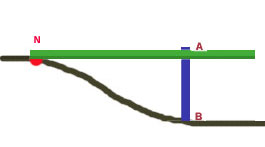Measure height differences
Who has a flat plot, it is quite easy for him to measure and lay out a garden. However, there are also many advantages, that speak for a hillside property. The creation of different terraces and the necessary stairs certainly makes a lot of work at first. Therefor offers an area, which not only comes up with flat and even forms, a variety of design options. Before actually planning, however, you should first think about the existing height differences. This is the only way to achieve, that the garden can also be designed as a harmonious unit.
What is the best way to do this?
To measure a slope, you need at least one or more longer roof battens, some sharpened posts and a spirit level.
First the zero point must be determined. An existing house wall or other structure is best suited for this. Something like that is not around, then the zero point can also be determined arbitrarily. In case you are not entirely sure, whether you have to or want to carry out several measurements, then it is appropriate, if you mark this freely chosen point with a stone or other marking.

After setting the zero point, the first roof batten is placed in the direction of the slope. One end comes to zero. The other end goes to one of the posts. The spirit level is used to adjust for that long, until the roof batten is level.

If you measure between points A and B., then you have the difference in height between the individual areas.
What do you do, but when the slope stretches quite a long way and one roof batten is not enough?

Then you start again at the foot of the post. You can imagine it that way:
The difference in altitude is now calculated from the distances:
"A to B" plus "B to C" plus "C to D".
But what if you want to calculate the gradient in percent?
In this case, you can approach the task in a similar way. However, the post is not simply hammered into the end of the roof batten, but at the end of the embankment.
Now you measure from the zero point to the post and have the length L.. Enter these values together with the measured height in the following formula:
percent (of the slope) = Height by length x 100
When I have measured the following:
- Length of the route: 10 Meter = 1000 cm
- Height difference (already added): 50 cm
- (Do not forget: It is essential to count on a unit of measurement. So either just centimeters or just meters)
Gradient in percent = 50 by 1000 times 100 = 0,5 %
For whom that is too complicated, he can perhaps console himself with the statement, that 1 Centimeter difference in height 1 Meters the same 1% Slope means. So correspond 6 Centimeter difference with a meter length then 6 % gradient.
So that water can easily drain off terraces or other flat surfaces, By the way, there should be a gradient of from the start 2 % plan on. That means, that the difference in altitude after 1 Meters already 2 Centimeters. So if you put your slats against one 4 Meter long seating area, so should the difference in altitude 8 Be centimeters. Otherwise it can happen, that the garden chairs are in the water after a long rain.